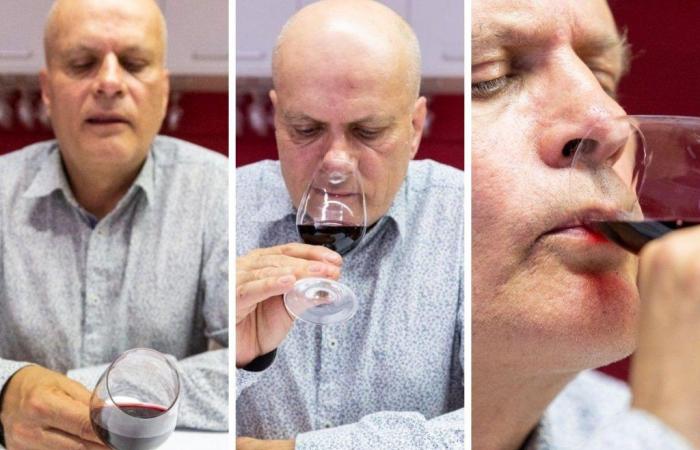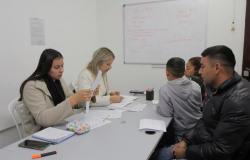Antonio Palacios, biologist, oenologist and professor of Sensory Analysis, details the three main processes of the tasting. The teacher encourages us to lose fear, to let sensations flow and, above all, to enjoy and let ourselves be carried away by what he transmits, the memories that … evokes: “The best wine is the one you like and the key is that a wine fits your taste, your taste never has to fit the wine.” For Antonio Palacios, we all have a taster inside: «There are no sensory mutilations, we just have to try to interpret what we perceive: it reminds us of fruit, wood…; He caresses us in the mouth, grabs us…; We like it, we don’t like it… Just that. We leave the astringency, round, fatty or sweet tannin to the experts.”
-
Visual Phase
Young or old wine«The curvature, the edging, will give us clues to the evolution of the wine»
«What the eye is going to tell us is what the wine is like, above all, the nuance. The nuance is the age, how the wine has evolved and, to do this, we tilt it over a white background and observe the transparency, the clarity… Normally, we will be looking at a well-filtered, clarified, clean wine ready for consumption, which means that no chemical or biological process has spoiled it. In this visual exercise, the teacher also suggests looking at the curvature (the edge), which will give us clues about the evolution of the color: «In red wines, the more brick or orange the edge is, the older and more orange the red wine will be. evolved; If it is a white, the greener tones will go towards yellow and colors that are a little more steely or orange and it means the same thing, that the wine is evolving. “The most important thing,” he continues, “is that the nuance gives us clues for later interpretations.” Is a young wine or an old wine better? «Perhaps before, old wine was more associated with quality and now youth is more fashionable, but neither one nor the other is better or worse. The important thing is what it suggests to you, what aromas and sensations it transmits to you, and whether they are pleasant or unpleasant to you. We will see it now in smell and taste, but the best wine is the one you like.
-
Olfactory phase
Let it flow«It is enough to lose the fear of wine to bring out memories»
«We put our nose into the glass for a long, deep sniff and we are going to try to interpret what we can perceive: youth, fruit, components such as wood… If a wine reminds us of fruit, it is already something great because it will entertain us. Then there are slightly more subtle languages and wine, for example, can give us an idea of the variety. There are more fruity, herbal, floral, vegetable varieties and, with training, we can discover them. The professor exercises his sense of smell and details his sensations: «This wine smells of fruit, of cherry and reminds me of juanola, of licorice. How is a liquorice wine going to smell? Thanks to fermentation, more than a thousand different volatile compounds arise: why shouldn’t there be one that smells like licorice? “It is characteristic of the Tempranillo variety, with very pleasant sweet, fruity and juanola touches.” In a second instance, the tasting continues: «Perhaps, the wine matures in wood and then we find aromas of vanilla, pastry, toasted, smoked, incense… These are aromas that we know and, if we lose respect for a wine, suddenly all that vocabulary emerges, your memories, your memories with your life experiences and the wine makes you remember them. “It’s enough to lose your fear of wine.”
-
Mouth
Stroke or grab«The key is that a wine fits your taste, never the other way around»
The idea is to enjoy the taste buds and concentrate on touch, that is, contact with the mouth. The professor takes a drink: «We like it, it gives us velvety sensations, it caresses us…, or we don’t like it, because it itches or scratches us… Just that. We don’t have to talk about astringency or round, fatty or sweet tannins… We can also feel if it is a little acidic, if it suits us well for the cool summer for example. The key is that a wine fits your taste, your taste never has to fit a wine. In the mouth, the other fundamental aspect is the aftertaste, the retronasal: «It’s wonderful, it’s a rewarding phenomenon. What does it mean? Our mind is very wise and what is good and pleasant will be rewarded in the form of gustatory memories of pleasure. Everything that makes us feel “uummm” in retronasal is because the mind asks for more and wants to repeat that positive sensation. That is, in retrolfaction the brain acts in the translation of that perception, giving much more information than direct olfaction. Therefore, the retrolfaction as a wine matures and ages becomes more complex and intense and this translates into the value of the wine.
#Argentina






